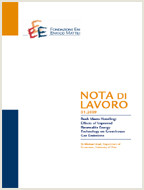Combining Climate and Energy Policies: Synergies or Antagonism? Modeling interactions with energy efficiency instruments

24.12.2011
Oskar Lecuyer, Ruben Bibas
Q28, Q41, Q48, Q58
Renewable Energy, Energy Efficiency, Energy Policy, Climate Policy, Policy Interaction
Energy: Resources and Markets
Giuseppe Sammarco
In addition to the already present Climate and Energy package, the European Union (EU) plans to include a binding target to reduce energy consumption. We analyze the rationales the EU invokes to justify such an overlapping and develop a minimal common framework to study interactions arising from the combination of instruments reducing emissions, promoting renewable energy (RE) production and reducing energy demand through energy efficiency (EE) investments. We find that although all instruments tend to reduce emissions and a price on carbon tends to give the right incentives for RE and EE too, the combination of more than one instrument leads to significant antagonisms regarding major objectives of the policy package. The model allows to show in a single framework and to quantify the antagonistic effects of the joint promotion of RE and EE. We also show and quantify the effects of this joint promotion on ETS permit price, on wholesale market price and on energy production levels.
